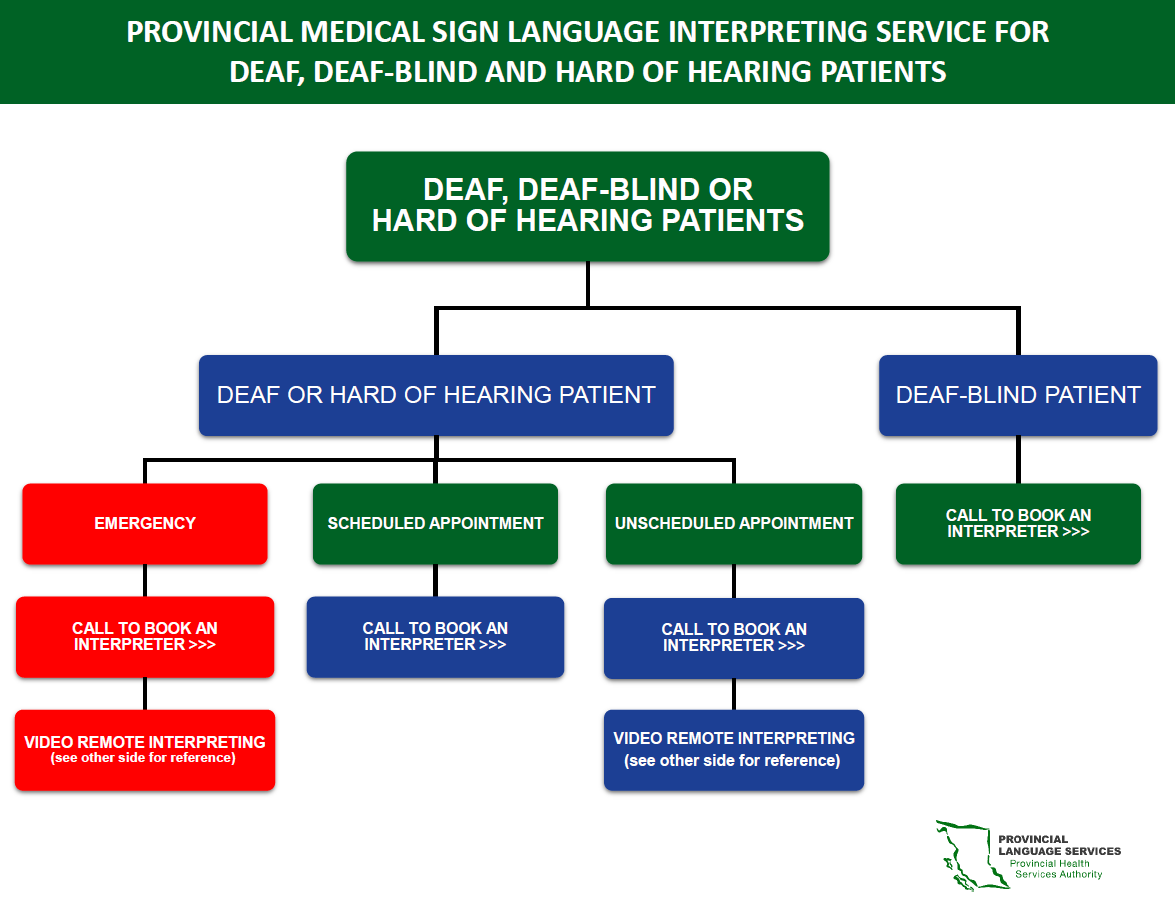Language interpreting
Provincial Language Services provides language interpreting for official minority language speakers, Deaf, Deaf-Blind and Hard of Hearing, and immigrant and refugee populations.
Interpreting is a process that requires the interpreter to listen to a message in the original language (source language), and render it in a different language (target language), bridging the communication gap between speakers or signers of different languages.
List of languages we interpret
Provincial Language Services provides interpreting services through different modalities to offer flexibility in our approach to creating access.
Some modalities suit clinical areas better than others, while other modalities allow for access in geographic areas that were not accessible previously.
On-site interpreting, otherwise known as face-to-face or in-person, is when an interpreter is scheduled to meet a patient who communicates in a language other than English, or Deaf, Deaf-Blind and Hard-of-Hearing patient at a given location for a medical appointment.
On-site interpreting is the preferred modality for most Deaf and Hard of Hearing patients and is the only workable modality for Deaf-Blind patients.
For spoken language, on-site interpreting is available only for Lower Mainland health authorities.
Virtual health visit interpreting is when an interpreter is scheduled to join virtual health visit appointments between a health care provider with patient who communicates in a language other than English or a Deaf and Hard-of-Hearing patient.
Zoom for Healthcare is the recommended platform for any virtual interpreter-assisted sessions, including group sessions,
Virtual health visit interpreting is not suitable for most Deaf-Blind patients.
Zoom for Healthcare allows for multilingual group sessions where interpreters can provide simultaneous interpreting in multiple languages directly and solely to patients who communicate in languages other than English. At the same time, the health care provider conducts their presentation in English for the general audience. Only the patient who communicates in a language other than English can hear the interpreter.
Video remote interpreting uses audio and video technologies via a device such as an iPad to provide language interpreting virtually. Video remote interpreting is available 24/7 and has on-demand access to:
- 40 spoken languages via video
- American Sign Language via video
- 200 spoken languages via audio
Video remote interpreting devices can be found in emergency departments in Interior Health, Fraser Health, Northern Health, Vancouver Coastal Health, Providence Health Care, BC Children's Hospital, and BC Women's Hospital. Other health authority programs and services may also have video remote interpreting devices.
BC Emergency Health Service has video remote interpreting installed on their B.C. paramedics-issued devices for Deaf and Hard of Hearing individuals.
Although on-site interpreting is the preferred modality for Deaf and Hard of Hearing patients, video remote interpreting is acceptable in geographic locations where there is no or limited access to in-person sign language interpreters and when the communication between the patient and provider will be short.
Video remote interpreting is also acceptable as an interim solution for Deaf and Hard of Hearing patients until an on-site sign language interpreter arrives.

Over the phone interpreting connects spoken language interpreters via telephone with the health care provider and patients who communicate in languages other than English. The interpreter converts the spoken language from one language to another, enabling listeners and speakers to understand each other.
Over the phone interpreting is an on-demand service available to B.C. health authorities, family practices and specialists.
This video provides a quick reference on accessing and working with an interpreter over the telephone.
For more details, paramedics should connect with their team leads.
T
Interpreters are language conduits who convey the messages of people who do not share the same language, culture, or way of communicating.
Spoken language interpreters are trained professional interpreters who bridge the communication between English speakers and speakers who communicate in languages other than English.
Spoken language interpreting services are available in over
200 languages.
Sign language interpreters are specially trained professional interpreters who bridge the communication between English speakers and sign language users. Sign language interpreters are hearing and fluent in the source language and sign language.
Deaf interpreters are individuals who are Deaf or Hard of Hearing and possess communication skills in both source language and sign language. A Deaf interpreter has extensive knowledge and understanding of Deafness, the Deaf community, and/or Deaf culture. The Deaf interpreter has been trained in the role and ethics of an interpreter and may also have specialized training and/or experience in the use of gestures, mime, props, drawings, home signs, and matching sentence structure and language development of the Deaf person for whom they are interpreting.
A professional interpreter is one who:
- Has proven language proficiency in both target and source languages;
- Has training from a recognized interpreting/translation education or training program or has been certified as an interpreter by a recognized professional association;
- Can accurately, wholly and faithfully render communication from one language to another
Professional interpreters adhere to a Code of Ethics and Standards that includes the following guiding principles:
- Accuracy and fidelity - preserves the meaning, style, and register of the source information;
- Confidentiality and privacy of the information provided for interpreting;
- Impartiality – ensures personal bias or beliefs do not impact or influence the interpreting; and
- Limitations of practice – linguistic limitation, time limitations, subject matter knowledge.
Please refer to the communication continuum below to know how to use other language resources such as volunteers or translation machines.
Family and friends should not be used as interpreters. The role of the family in an interpreter-assisted appointment should be one of support, similar to the role of the family in an appointment in which the health care provider and patient speak directly.
Machine translation (Google Translate) and other ad hoc language resources (paper and pen or family/friend) should only be used for non-medical conversations that do not require verification, do not increase the risk in case of miscommunication or breach of confidentiality, and when no other resources are available.
